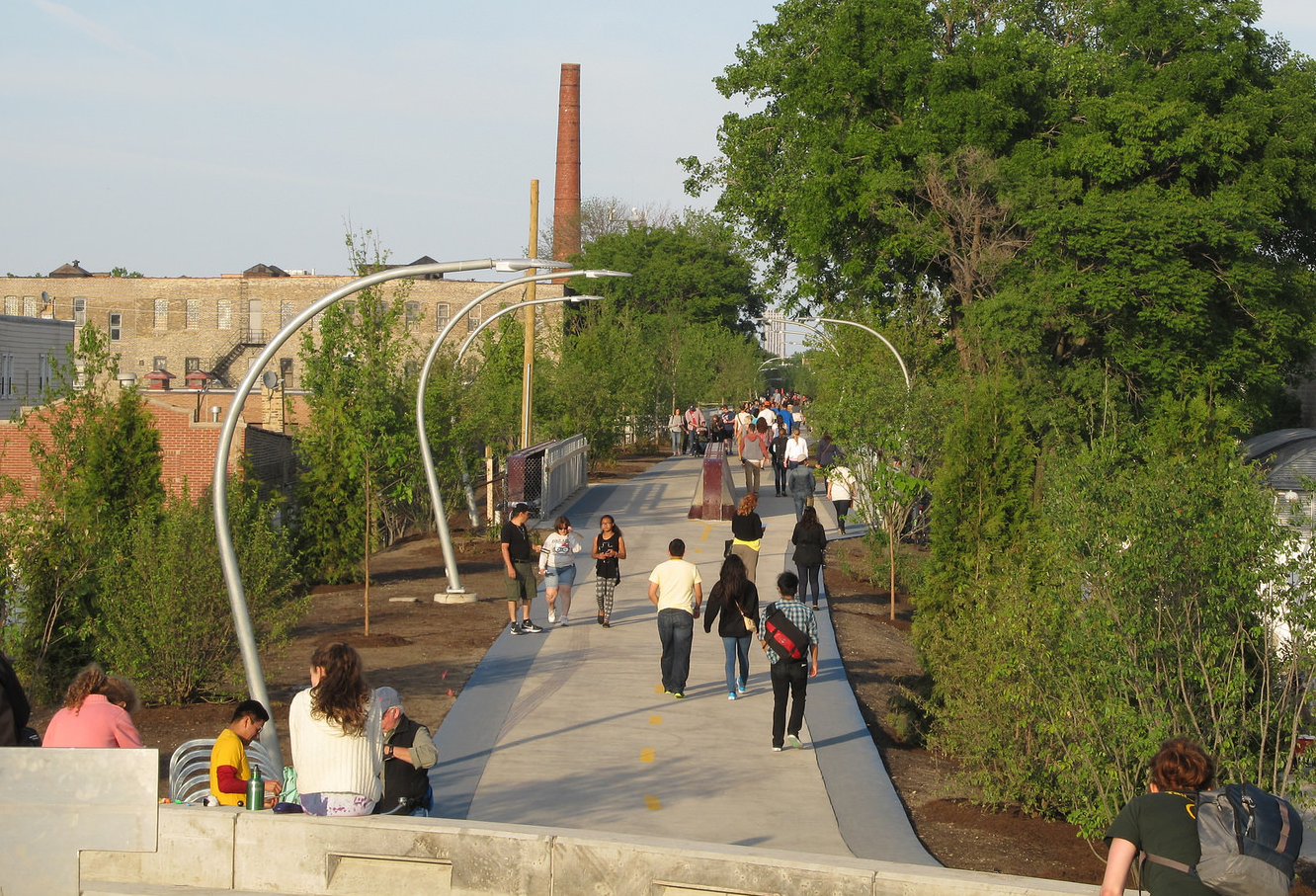In a recent study titled “'We’re not in the business of housing': Environmental nonprofitization of green infrastructure projects” by Alessandro Rigolon, assistant professor at the University of Illinois at Urbana-Champaign in recreation, sport, and tourism; and Jeremy Nemeth, associate professor of urban planning and regional planning at the University of Colorado at Denver, the authors look at the impact of park nonprofits leading large green infrastructure projects (LGIPs) with a particular focus on Chicago's Bloomingdale Trail, aka The 606.
The authors found that when cities delegate the leadership of these projects to park nonprofits there can be benefits but it can also accelerate "environmental gentrification," which they define as "the influx of wealthy residents to historically disenfranchised neighborhoods due to new green spaces." This phenomenon has been under increased scrutiny in recent years due to housing speculation associated with the Bloomingdale, New York City's High Line, and the Atlanta BeltLine.
Rigolon and Nemeth reached their conclusions after interviewing 16 key players in the green infrastructure planning field, including members of nonprofit organizations and city officials, and a review of planning documents. One of the main points they make is that having park nonprofits manage projects for cities can lead to the fragmentation of green space development and affordable housing goals. It can also result in decision-makers focusing on the environmental and public health benefits of green infrastructure, while not paying enough attention to the potential for the displacement of longtime residents. Delegating project management to nonprofits can also reduce accountability for both public and non-state actors.
The authors chose to study Chicago's Bloomingdale Trail because Mayor Rahm Emanuel has made big-ticket sustainable transportation and parks projects a hallmark of his administration, and because studies have found a clear link between the Bloomingdale and rising housing costs along its corridor. Before The 606 became a reality, some residents had been pushing for the conversion of the old Bloomingdale Line railroad right-of-way into a trail for decades. The proposal was mentioned in the City of Chicago’s (1998) CitySpace Plan, and in the mid-2000s it was included in the Logan Square Open Space plan, the Logan Square Quality of Life Plan, and the Humboldt Park Quality of Life Plan.
In 2010, the Trust for Public Land, a national nonprofit with a mission to create parks and preserve open space, signed a contract with the Chicago Park District to become the lead private partner of the project. TPL was tasked with spearheading fundraising efforts, including securing donations from large private donors; conducting community outreach; and acquiring land on behalf of the city. When Emanuel took office in 2011, he pledged to complete the Bloomingdale Trail before the end of his first term.
The authors point out that having TPL manage the project had upsides, such as the organization's experience with raising money and community outreach. However, they argue, having the organization lead the development of the trail paved the way for environmental gentrification, because preserving affordable housing wasn't a central focus for TPL.
Local residents who spoke with the researchers stressed that they felt Emanuel coopted the planning process in order to fulfill his campaign process. One longtime Logan Square resident and community organizer, who is not named in the article, said:
The irony is that we empowered community members in the 2000s in a Quality of Life plan for Logan Square…Research at the time showed that Logan Square had the lowest amounts of green space in the city. We had young people in our community going door-to-door to survey people and say ‘What issues are you concerned about and how can we address those?’ The irony today is that the families at the time said ‘Well there is an abandoned rail line down the street that has become a hub for crime and we feel unsafe. Can the city transform that into a green space for our families?’ We couldn't foresee at the time that today, in 2017, [The 606] would be the amenity that would actually be displacing us – something that we fought so hard for.
According to the authors, staff from TPL’s Chicago office acknowledged that when they led the project, their focus wasn’t on preserving affordability. “We are not in the business of housing," one unnamed staffer said. "We are in the business of conservation and building parks. Housing is not what we do; that's not our mission.”
An affordable housing advocate quoted in the article argued that responding to gentrification and displacement threats is difficult, because different community groups are operating in silos. “There is no overarching coalition to deal with these issues; even our organizing is segregated.”
An affordable housing developer contrasted this fragmentation among community groups to the seemingly organized way that Emanuel approached developing the Bloomingdale, “The Mayor wanted The 606 developed," the developer said. "He was able to marshal the Trust for Public Land, some of the local aldermen, and the federal government. So, on the one hand, there is this is this singular vision that can drive the process and has influence. On the other hand, the opposition is a bunch of people all over the place, with different opinions and different reasons.”
But a Chicago Department of Planning and Development official who was interviewed said fragmentation is also an issue among city departments. “This idea that you were planning for all of these things at the same time [parks, transportation, housing], that was not happening.”
While the authors of found flaws with the ways LGIPs, specifically The 606, have been planned in the past, they also offered suggestions on to make future projects more equitable. One of the study’s main points is that these initiatives need to part of broader, holistic planning efforts that integrate investment in green space and active transportation with affordable housing.
![]()
Did you appreciate this post? Consider making a donation through our PublicGood site.




